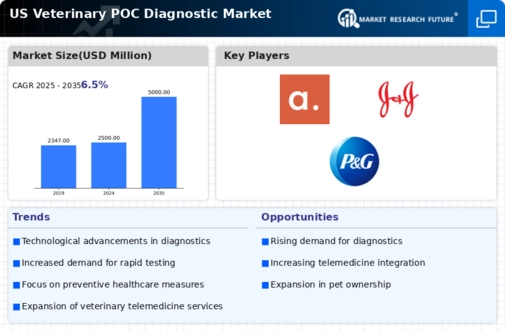The veterinary poc-diagnostic market is characterized by a dynamic competitive landscape, driven by innovation, technological advancements, and a growing emphasis on rapid diagnostics. Key players such as Idexx Laboratories (US), Zoetis (US), and Thermo Fisher Scientific (US) are at the forefront, each adopting distinct strategies to enhance their market presence. Idexx Laboratories (US) focuses on expanding its product portfolio through continuous innovation, particularly in point-of-care testing solutions, which positions it as a leader in the market. Zoetis (US) emphasizes strategic partnerships and acquisitions to bolster its diagnostic capabilities, while Thermo Fisher Scientific (US) leverages its extensive distribution network to enhance accessibility and customer engagement. Collectively, these strategies contribute to a competitive environment that is increasingly centered around technological differentiation and customer-centric solutions.
In terms of business tactics, companies are increasingly localizing manufacturing and optimizing supply chains to enhance efficiency and responsiveness to market demands. The market structure appears moderately fragmented, with several key players exerting influence while also allowing for niche companies to thrive. This fragmentation fosters a competitive atmosphere where innovation and customer service are paramount, as companies strive to differentiate themselves in a crowded marketplace.
In October 2025, Idexx Laboratories (US) announced the launch of a new rapid diagnostic test for canine parvovirus, which is expected to significantly reduce the time required for diagnosis. This strategic move not only enhances Idexx's product offerings but also reinforces its commitment to improving veterinary care through timely diagnostics. The introduction of such innovative solutions is likely to strengthen Idexx's market position and appeal to veterinary professionals seeking efficient diagnostic tools.
In September 2025, Zoetis (US) expanded its collaboration with a leading veterinary telehealth platform, aiming to integrate diagnostic services with telemedicine solutions. This partnership is strategically important as it aligns with the growing trend of digital health solutions in veterinary care, potentially increasing access to diagnostics for pet owners and veterinarians alike. By merging traditional diagnostics with telehealth, Zoetis is positioning itself to meet evolving consumer demands and enhance the overall veterinary care experience.
In August 2025, Thermo Fisher Scientific (US) unveiled a new line of portable diagnostic devices designed for use in field settings. This development reflects a strategic focus on enhancing accessibility to diagnostic tools in various environments, particularly in rural areas where veterinary services may be limited. The introduction of portable solutions is likely to expand Thermo Fisher's market reach and cater to a broader customer base, thereby reinforcing its competitive edge.
As of November 2025, current trends in the veterinary poc-diagnostic market are increasingly defined by digitalization, sustainability, and the integration of artificial intelligence (AI) into diagnostic processes. Strategic alliances are becoming more prevalent, as companies recognize the value of collaboration in driving innovation and expanding market reach. Looking ahead, competitive differentiation is expected to evolve, with a notable shift from price-based competition towards a focus on innovation, technological advancements, and supply chain reliability. This transition suggests that companies that prioritize these elements will likely emerge as leaders in the veterinary poc-diagnostic market.














Leave a Comment